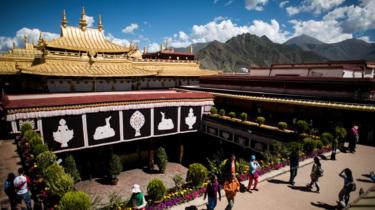 TWITTER
TWITTER
A fire has hit the most important shrine in Tibetan Buddhism - the Jokhang Monastery in Lhasa.
Footage posted online showed flames billowing from the roof and what appeared to be at least one gutted pagoda. No casualties were reported.
Chinese state media said the blaze started on Saturday evening and was soon put out.
The extent of damage to the sprawling compound is unclear. State media said there was no damage to cultural relics.
Tibet, the remote and mainly Buddhist territory known as the "roof of the world", is governed as an autonomous region of China.
Reports say that Chinese authorities quickly tried to block footage and images of the fire appearing on social media.
Beijing maintains tight control of news reports from Tibet, where Buddhist sites have been a focal point for separatist unrest in the past.
Foreign journalists are not able to enter Tibet without special permission.
Tibetan writer Tsering Woeser told AFP she was "very worried" about the state of the monastery.
"Tibetans consider Lhasa to be a sacred place, but Jokhang is a sacred place within that sacred place - the most sacred in all of Tibet," she said.
"Some people say it's only because of Jokhang that the holy city of Lhasa exists at all."
"No matter where they are in the world, Tibetans all wish to come to Lhasa to pray at Jokhang; it's the wish of a lifetime. Many who make pilgrimage to Lhasa prostrating do so just to visit the temple," she added.
The fire comes as Tibetans celebrate Losar, their traditional new year, which began on Friday.
 AFP/GETTY IMAGES
AFP/GETTY IMAGES
Tibet has had a tumultuous history, during which it has spent some periods functioning as an independent entity and others ruled by powerful Chinese and Mongolian dynasties.
China sent in thousands of troops to enforce its claim on the region in 1950. Some areas became the Tibetan Autonomous Region and others were incorporated into neighbouring Chinese provinces.
China says Tibet has developed considerably under its rule.
But rights groups say China continues to violate human rights, accusing it of political and religious repression - something Beijing denies.
No comments:
Post a Comment